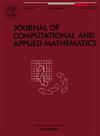Non-Intrusive Reduced Basis two-grid method for flow and transport problems in heterogeneous porous media
IF 2.1
2区 数学
Q1 MATHEMATICS, APPLIED
Journal of Computational and Applied Mathematics
Pub Date : 2024-10-15
DOI:10.1016/j.cam.2024.116321
引用次数: 0
Abstract
Due to its non-intrusive nature and ease of implementation, the Non-Intrusive Reduced Basis (NIRB) two-grid method has gained significant popularity in numerical computational fluid dynamics simulations. The efficiency of the NIRB method hinges on separating the procedure into offline and online stages. In the offline stage, a set of high-fidelity computations is performed to construct the reduced basis functions, which is time-consuming but is only executed once. In contrast, the online stage adapts a coarse-grid model to retrieve the expansion coefficients of the reduced basis functions. Thus it is much less costly than directly solving a high-fidelity model. However, coarse grids in heterogeneous porous media of flow models are often accompanied by upscaled hydraulic parameters (e.g. hydraulic conductivity), thus introducing upscaling errors. In this work, we introduce the two-scale idea to the existing NIRB two-grid method: when dealing with coarse-grid models, we also employ upscaled model parameters. Both the discretization and upscaling errors are compensated by the rectification post-processing. The numerical examples involve flow and heat transport problems in heterogeneous hydraulic conductivity fields, which are generated by self-affine random fields. Our research findings indicate that the modified NIRB method can effectively capture the large-scale features of numerical solutions, including pressure, velocity, and temperature. However, accurately retrieving velocity fields with small-scale features remains highly challenging.
用于解决异质多孔介质中的流动和传输问题的非侵入式还原基础双网格法
由于其非侵入性和易于实施的特点,非侵入还原基(NIRB)双网格法在数值计算流体动力学模拟中大受欢迎。NIRB 方法的效率取决于将程序分为离线和在线两个阶段。在离线阶段,需要进行一系列高保真计算来构建还原基函数,虽然耗时,但只需执行一次。相比之下,在线阶段则通过调整粗网格模型来检索还原基函数的扩展系数。因此,它比直接求解高保真模型的成本要低得多。然而,异质多孔介质流动模型中的粗网格往往伴随着放大的水力参数(如水力传导率),从而引入放大误差。在这项工作中,我们在现有的 NIRB 双网格方法中引入了双尺度思想:在处理粗网格模型时,我们也采用了放大模型参数。离散化误差和放大误差都可以通过整流后处理得到补偿。数值示例涉及异质水力传导场中的流动和热量传输问题,这些问题由自线性随机场生成。研究结果表明,改进的 NIRB 方法能有效捕捉数值解的大尺度特征,包括压力、速度和温度。然而,精确获取具有小尺度特征的速度场仍然具有很大的挑战性。
本文章由计算机程序翻译,如有差异,请以英文原文为准。
求助全文
约1分钟内获得全文
求助全文
来源期刊
CiteScore
5.40
自引率
4.20%
发文量
437
审稿时长
3.0 months
期刊介绍:
The Journal of Computational and Applied Mathematics publishes original papers of high scientific value in all areas of computational and applied mathematics. The main interest of the Journal is in papers that describe and analyze new computational techniques for solving scientific or engineering problems. Also the improved analysis, including the effectiveness and applicability, of existing methods and algorithms is of importance. The computational efficiency (e.g. the convergence, stability, accuracy, ...) should be proved and illustrated by nontrivial numerical examples. Papers describing only variants of existing methods, without adding significant new computational properties are not of interest.
The audience consists of: applied mathematicians, numerical analysts, computational scientists and engineers.

 求助内容:
求助内容: 应助结果提醒方式:
应助结果提醒方式:


